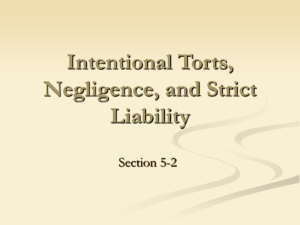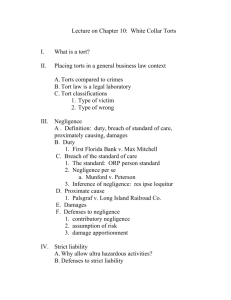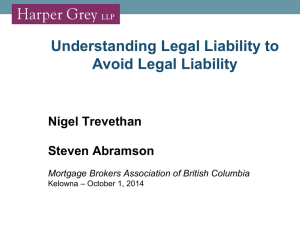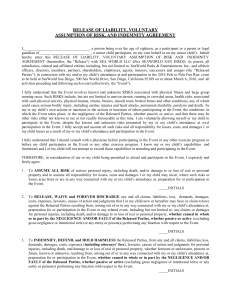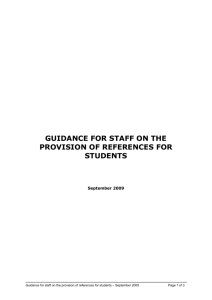chapter eight
advertisement
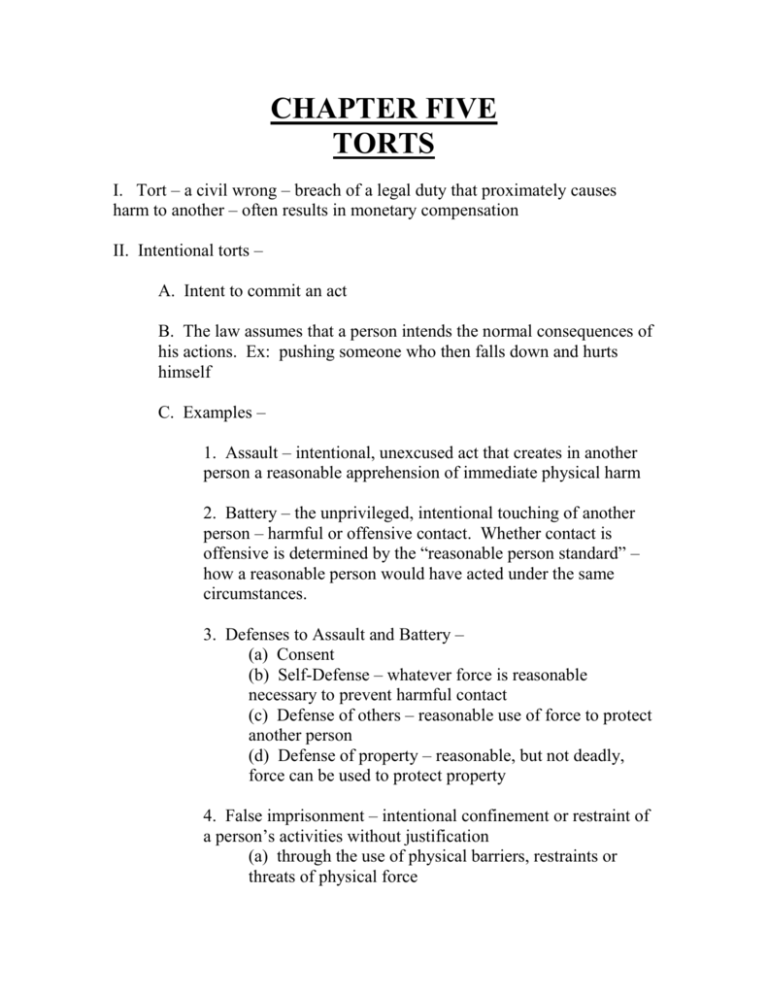
CHAPTER FIVE TORTS I. Tort – a civil wrong – breach of a legal duty that proximately causes harm to another – often results in monetary compensation II. Intentional torts – A. Intent to commit an act B. The law assumes that a person intends the normal consequences of his actions. Ex: pushing someone who then falls down and hurts himself C. Examples – 1. Assault – intentional, unexcused act that creates in another person a reasonable apprehension of immediate physical harm 2. Battery – the unprivileged, intentional touching of another person – harmful or offensive contact. Whether contact is offensive is determined by the “reasonable person standard” – how a reasonable person would have acted under the same circumstances. 3. Defenses to Assault and Battery – (a) Consent (b) Self-Defense – whatever force is reasonable necessary to prevent harmful contact (c) Defense of others – reasonable use of force to protect another person (d) Defense of property – reasonable, but not deadly, force can be used to protect property 4. False imprisonment – intentional confinement or restraint of a person’s activities without justification (a) through the use of physical barriers, restraints or threats of physical force (b) What about a storeowner’s detention of an alleged shoplifter? (1) must have probable cause to detain (2) detention must be in a reasonable manner for a reasonable period of time 5. Intentional Infliction of Emotional Distress – intentional act that amounts to extreme and outrageous conduct resulting in severe emotional distress to another (a) Ex: telephone prank that spouse has been killed in a car wreck (b) limitations – requires more than an indignity or annoyance alone (c) Usually extreme conduct which results in extreme emotional damages 6. Defamation – wrongfully hurting another person’s good reputation. (a) Libel – written defamation (b) Slander – oral defamation (c) Examples of defamation ‘per se’ (1) that someone has a loathsome communicable disease (2) that someone has committed improprieties while engaging in a profession or trade (3) that someone has committed or been imprisoned for a serious crime (4) that a woman in unchaste (d) Publication requirement – communications to persons other than the defamed party (e) Defenses to defamation action (1) Truth is an absolute defense (2) Privilege – immunity from liability – Ex: absolute immunity in judicial proceedings (f) Public figures – requirement of actual malice – statement made with either knowledge of falsity or a reckless disregard of the truth (1) Public officials – N.Y. Times v. Sullivan, U.S. Supreme Court, 1964 (2) Public figures – Curtis Publishing Co. v. Butts, U.S. Supreme Court, 1966 8. Misrepresentation (Fraud) (a) innocent misrepresentation (b) fraudulent misrepresentation (1) misrepresentation of facts or conditions with knowledge that they are false or with reckless disregard for the truth (2) intent to induce another to rely on the misrepresentation (3) justifiable reliance by the harmed party (4) damages suffered as the result of the reliance (5) causal connection between the misrepresentation and the damages suffered 9. Wrongful interference (a) wrongful interference with a contractual relationship (1) valid, enforceable contract between 2 parties (2) third party must know of the contract (3) third party must intentionally cause either of the other 2 parties to breach the contract (b) wrongful interference with a business relationship III. Intentional torts against property A. Trespass to Land 1. Whenever a person, without permission, enters onto, above, or below the surface of land owned by another 2. Old laws – trespasser is liable for damages and landowner is not liable for injuries sustained by the trespasser 3. Newer laws -- regarding injuries sustained by the trespasser (a) reasonable duty of care – Ex: duty to warn of the presence of guard dogs (b) attractive nuisance – Ex: children attracted to trespass to get to a swimming pool 4. Defenses (a) trespass to assist someone in danger (b) licensee – one who is invited to enter property for licensee’s benefit. Ex: football game B. Conversion (civil theft) – wrongful taking of property from the rightful owner C. Disparagement of Property – Ex: slander of title – casting doubts on another person’s ownership of property IV. Unintentional torts – Negligence A. Negligence – the failure to exercise the standard of care that a reasonable person would exercise in similar circumstances – duty, breach, damage, causation. B. Duty of Care – the duty to exercise reasonable care in dealings with others, so as not to infringe upon the interests of others. 1. Reasonable Person Standard – the standard of behavior expected by a hypothetical “Reasonable Person”. A breach of this standard may result in liability. 2. The duty of landowners (a) generally landowners are expected to exercise reasonable care to protect persons coming onto their property from harm. (b) Business Invitee – i.e., customers – landowner should exercise reasonable care to protect customers from foreseeable risks for which the landowner knew or should have known about. Duty to warn. Duty to discover and remove hidden dangers. (c) Duty of professionals – malpractice – conduct must be consistent with professional status. C. Injuries and damages – legally recognizable injury 1. Compensatory damages – reimbursement for actual losses incurred 2. Punitive damages – intended to punish the wrongdoer and deter others – no punitive damages in a negligence action D. Causation – the breach of duty must have cause the injury 1. Causation in Fact – “But for” the wrongful act, the injury would not have occurred 2. Proximate Cause – legal cause – when the connection between an act and an injury is strong enough to justify imposing legal liability – foreseeability of the risk 3. Palsgraf v. Long island Railroad (1928) N.Y. Court of Appeals – the classic case on the issue of proximate cause E. Defenses to Negligence Actions 1. Assumption of the risk (a) knowledge of the risk; AND (b) voluntary assumption of the risk (c) Example: race car driver injured in a wreck during a race 2. Superceding cause – unforeseeable intervening event which breaks the connection between a wrongful act and injury to another 3. Contributory Negligence – failure to exercise reasonable care in looking out for yourself (a) Contributory negligence – absolute bar to recovery in some states – no recovery by the Plaintiff if the Plaintiff was also negligent. Exception: “Last Clear Chance” doctrine. Alabama is a contributory negligence state. (b) Comparative negligence – liability determined based upon each party’s negligence – offset for Defendant due to Plaintiff’s negligence. F. Special Negligence Doctrines and Statutes 1. RES IPSO LOQUITUR: “the thing speaks for itself”. Example: thumb in a sealed softdrink bottle. The Plaintiff doesn’t have to prove how the negligence occurred. 2. NEGLIGENCE PER SE: the violation of a statute or ordinance is automatically negligence. 3. ALABAMA GUEST STATUTE: a guest passenger in an automobile cannot sue the driver of his automobile for negligence in causing a wreck which resulted in the passenger’s injury. 4. GOOD SAMARITAN STATUTE: persons who are aided voluntarily by another cannot sue the person who aided them for negligence 5. DRAM SHOP ACT: a bar owner can be held liable to a third party for injuries caused by a person who got drunk in his bar.


